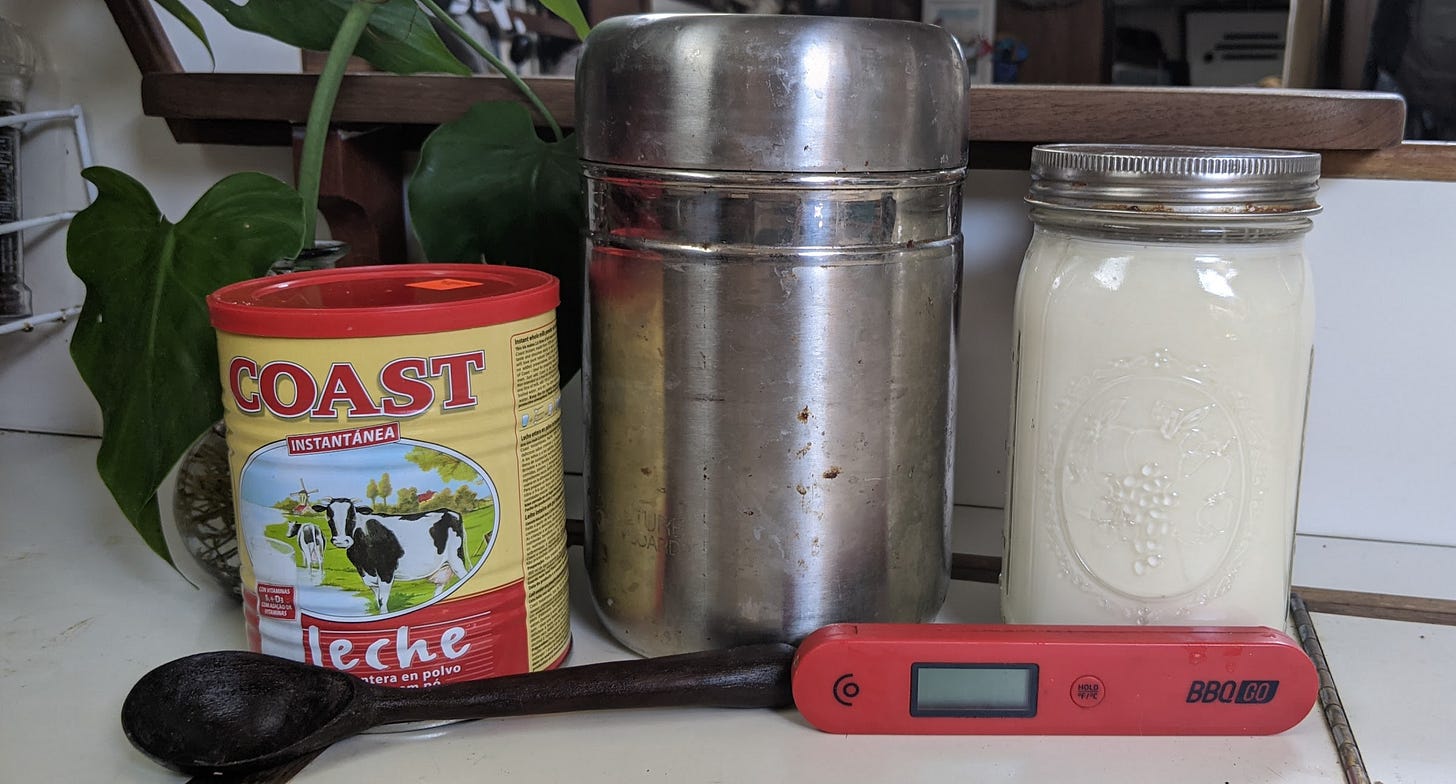This is Clouds Form Over Land, weekly writing about resilience, imperfectionism, and our relationship to the earth.

I’ve been making yogurt mostly consistently for the past year or so — each last spoonful kicking off every new batch.
Before we sailed away from community we found in the Sea of Cortez and Bocas del Toro, I gifted lessons and scoops of yogurt culture to friends. Lactobacillis Gremel-cus lives on in the Pacific and Caribbean!
A dear friend gifted me The Art of Fermentation by Sandor Katz, an encyclopedic view of techniques around the world and across the ages. He included stories of people tucking sourdough starters and smears of yogurt on kerchiefs for long voyages to new lands, as well the cultural know-how for ferments that don’t require starters, like sauerkraut. Every continent has a tradition of probiotics. Sudan has 60 different types! I enjoyed reading this essay about a woman’s parallel pandemic connection with her Lebanese grandmother who fled in 1918 and carried yogurt starter along for the journey.
Yogurt is said to have first kicked off in the 6th century BCE when some Central Asian herdsmen stored excess goat milk in animal stomachs. The stomachs contained bacteria that transformed the milk into a hearty, healthy, stable snack. Yum! Genghis Khan and the Mongol army ate yogurt, the ancient Greeks consumed a similar substance, and Indian emperor Akbar allegedly preferred mustard and cinnamon flavorings.
These days we make yogurt (or yoghurt depending on where you live) by pastuerizing milk, a process sorted out by French scientist Louis Pasteur in the 1860s and perhaps others in earlier, undocumented fermentation experiments. Louis demonstrated that abnormal fermentation of wine and beer could be prevented by heating the beverages for a few minutes, and later the simple process was applied to milk to rid us of spooky sounding things like mycobacterium tuberculosis.
After the milk is heated to 115 - 120 °F, starter is added and the vessel is left for 5-10 hours in an insulated container. Companies have made a variety of gizmos and ingenious people have gotten along just fine without them too by using thermoses or placing in the oven with a pot of boiling water alongside - this video explains it well.
“Starter” or “culture” is a fancy name for a substance with live active cultures. This could be yogurt from the store or previous batch. I have also used powdered starter to bail myself out when a batch was past its prime.
I use this recipe from one of my sailing heroes, Carolyn Sherlock. Her method with dehydrated milk is really conducive for boat life — simply put a kettle of water on the stove and mix hot and cold to the magic temperature. Scott gifted me a thermos similar to this one - no electricity is required! The vessel is only a bit bigger than the jar itself and keeps the yogurt-to-be secure enough that I have made many batches while sailing.
Repetition has developed my technique into a quick flurry, but it was a little intimidating when I was first getting started. The key is to get the temperature right and trust the bacteria to do the rest. From there, experiment with fermentation time and milk, dehydrated milk, and cream to arrive at desired thickness and tartness. It only takes a minute or two of stove time to reach the required temperature. I waited three hours for the temperature to fall back down in one early batch.
Yogurt was made at home until 1905 when Bulgarian microbiologist Stamen Grigorov discovered Lactobacillus bulgaricus. The familiar Dannon company began producing yogurt commercially in 1919 in Barcelona and it is now available abundantly in plastic containers in many flavors with lots of sugar.
Modern life is often quite busy and making something that can easily be added to the grocery cart might be hard to justify with your precious minutes. Nonetheless, setting the stage for these bacteria to perform and consuming it to help our own digestion is tart and satisfying. If you’re curious, give it a try! If you have questions, get in touch.
What to do with all this yogurt?
Add a few tablespoons of sugar and pop in the freezer for DIY froyo. Add a dollop to this lemony turmeric cake. Top off soups, stews, and chilis. Substitute in recipes for cream or sour cream. Blend it into mango lassis and other smoothies, and of course, good old yogurt and granola.
Make something from raw materials that you would usually get storebought.
Deepen your understanding of what’s happening in Iran. This could be searching “what is going on in Iran?”, listening to a podcast, reading an article, watching a documentary, connecting with a community member. All people deserve body soverignty and these teen girls are proclaiming theirs.
Check your voter registration status and/or register at vote.org. It’s not too early to make your plan for November 8 - I’m working on mine!
Take a nap.
Written in the spirit of not letting what we can’t do get in the way of what we can.
Did you try any of these? I’d love to hear about it.



